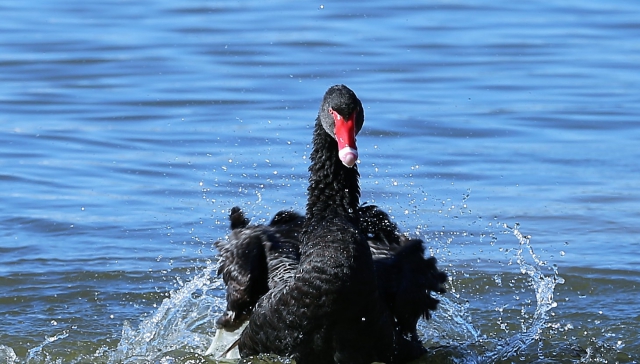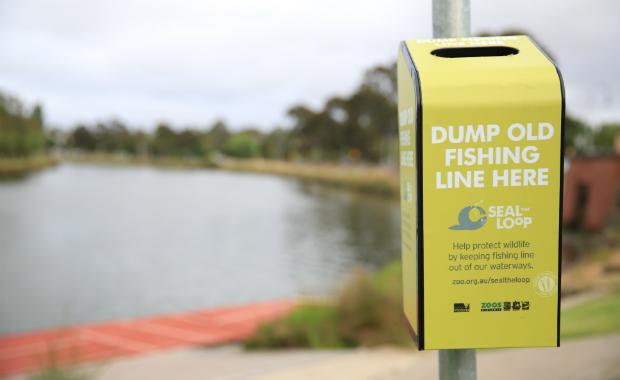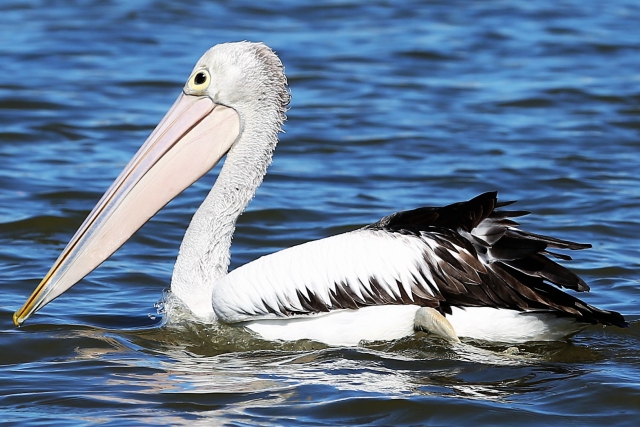This story begins a few Sundays back, when my neighbours Jan and John spotted a swan in distress from their lakeside garden. The swan, later confirmed to be male, had tangled himself in a discarded fishing line, that then wrapped itself around his leg, wing and neck, giving it an almost puppet-like pulling posture each time it tried to move.
The AGL Marine Response Unit was called and responded immediately, arriving within 30 minutes from the time Jan and John rang them. Liza from the AGL Unit was able to cut the fishing lines from the swan, and transported it to Melbourne Zoo despite believing his future looked quite bleak.
Fortunately, the Veterinary staff managed to clear the fishing lines and treat the swan for the injuries he sustained. The swan was later released back into the lake, where he paddled happy and free, back to join his partner and their three cygnets. I spoke with Mark Keenan from the AGL Marine Response Unit about the incident, and others like it.

Mark told me that the Unit is regularly freeing birds wrapped in fishing lines. Light-weight fishing lines are a big threat, as they tangle so easily. These lines have no stretch and will readily cut into the birds which can leave them maimed or cause death; most birds become entangled when they're foraging for food beneath the water. The issue begins when a length of discarded fishing line accidently catches on a bird’s foot, for example. The bird tries to kick the line off, and though they can sometimes free themselves in other cases the lines wrap around their legs or feet.
Mark says he’s also seen a number of other injuries occurring in birds coming into contact with fishing lines, such as line being swallowed or hooks attaching to parts of the bird. Additionally, fishing lines don’t biodegrade or break down quickly, and can tighten around the bird; especially when the area affected begins to swell.
The best way to avoid this from happening is to avoid dropping, snapping off or cutting off fishing lines. Where appropriate, educate others on the proper disposal of fishing line and hooks. If you fish yourself, you can use a float on your line to prevent the hooks snagging in seagrass. Preventing the snagging will prevent the need to cut lines.
In addition to this, Seal the Loop bins are provided around the lake for proper fishing line disposal.

Mark also told us that from his own observations, he had found that birds often form an association between the action of a person throwing food, and the action of a person casting a fishing line. The birds begin to think that the cast line is food, so will follow it which can lead to them getting caught in lines or having hooks caught in their beaks if the line is baited.
This led me to ask Mark about feeding birds.
Mark advises that we avoid feeding our feathered friends, and instead encourages creating a friendly environment for birds. He says that, just like in humans, a constant supply of ‘artificial’ food (such as white bread) can be unhealthy for the birds.
Although feeding birds is strongly discouraged, the reality is that around a third to half of the households in this country feed birds at their home or local parks. For many people (and especially children), feeding birds is their main relationship with the wild.
So, if you want to feed the birds on our lake or in your garden, then there are a few simple rules you should follow to make sure you feed them the correct way:
- Remember it’s a snack, not a meal. The birds only need a little to eat and they will (and should) get most of their diet the natural way
- Keep it clean and wash food scraps before feeding them to birds
- Simple is best; avoid anything processed (including bread or mince), or anything that contains salt or sugar
- Ensure you only give them foods that are compatible with their natural diet
Shredded lettuce placed in the water is a healthy food for most swans and ducks. You can also vary with a cos lettuce, endive, cracked corn, wheat and seeds. Always place these into the shallows of the water, instead of throwing it in. Don’t feel disappointed if they turn their nose and give you a look that says ‘OK, where’s the bread?’, persist and they will get used to it and enjoy their healthier snack options.
We residents of Sanctuary Lakes are extremely fortunate in having some of the most beautiful and iconic birds as our neighbours, and with that comes a responsibility towards them. Mark tells me that in his time with the AGL Marine Response Unit he has seen birds in a state of horrible distress and suffering, due to human’s often innocent actions.

The good news is that you can help prevent this happening. By following the above guidelines if you do choose to feed birds, by fishing conscientiously and using floats on your lines to prevent the need to cut them, by properly disposing of fishing lines and hooks, and by simply keeping your eyes peeled for discarded fishing lines whenever you go walking around the lake. If you do come across one, wind it up into a tight ball and put them in the Seal The Loop bins provided at locations around the lake.
If you see injured or distressed marine wildlife, please contact the AGL Marine Response Unit on 1300 AGL MRU (1300 245 678).